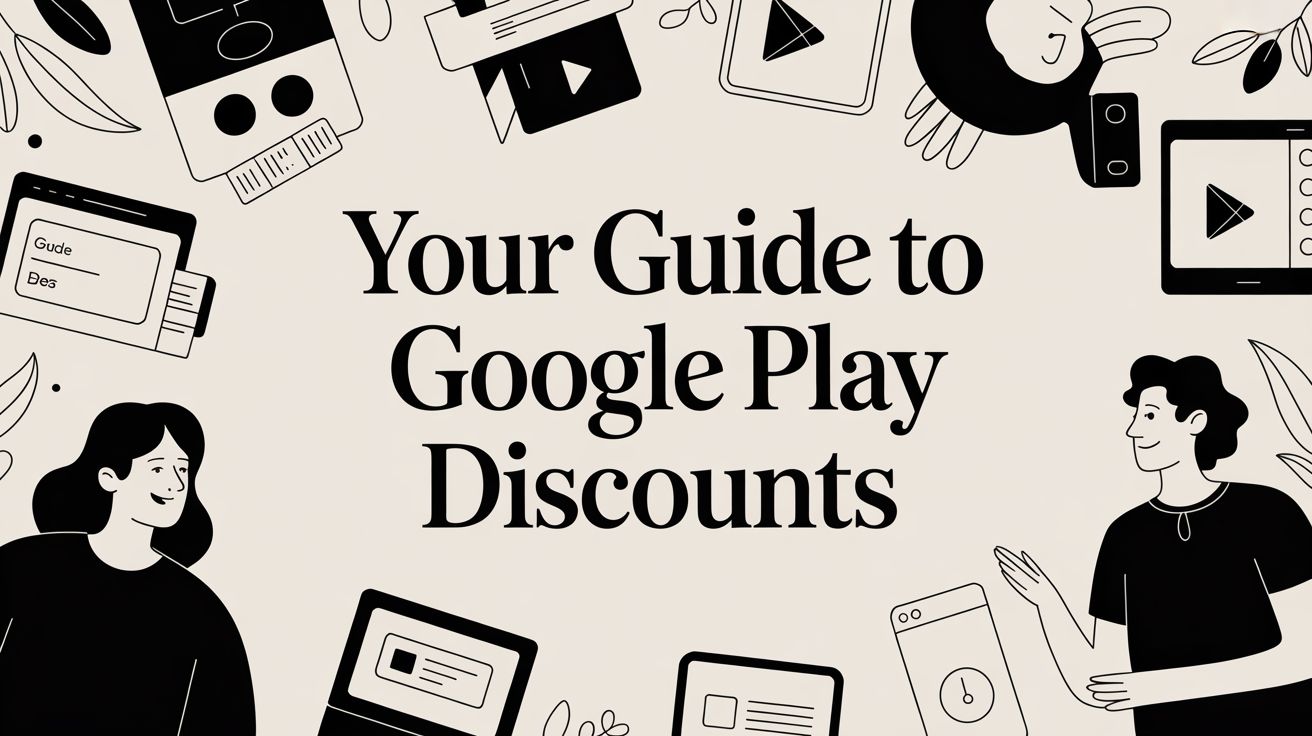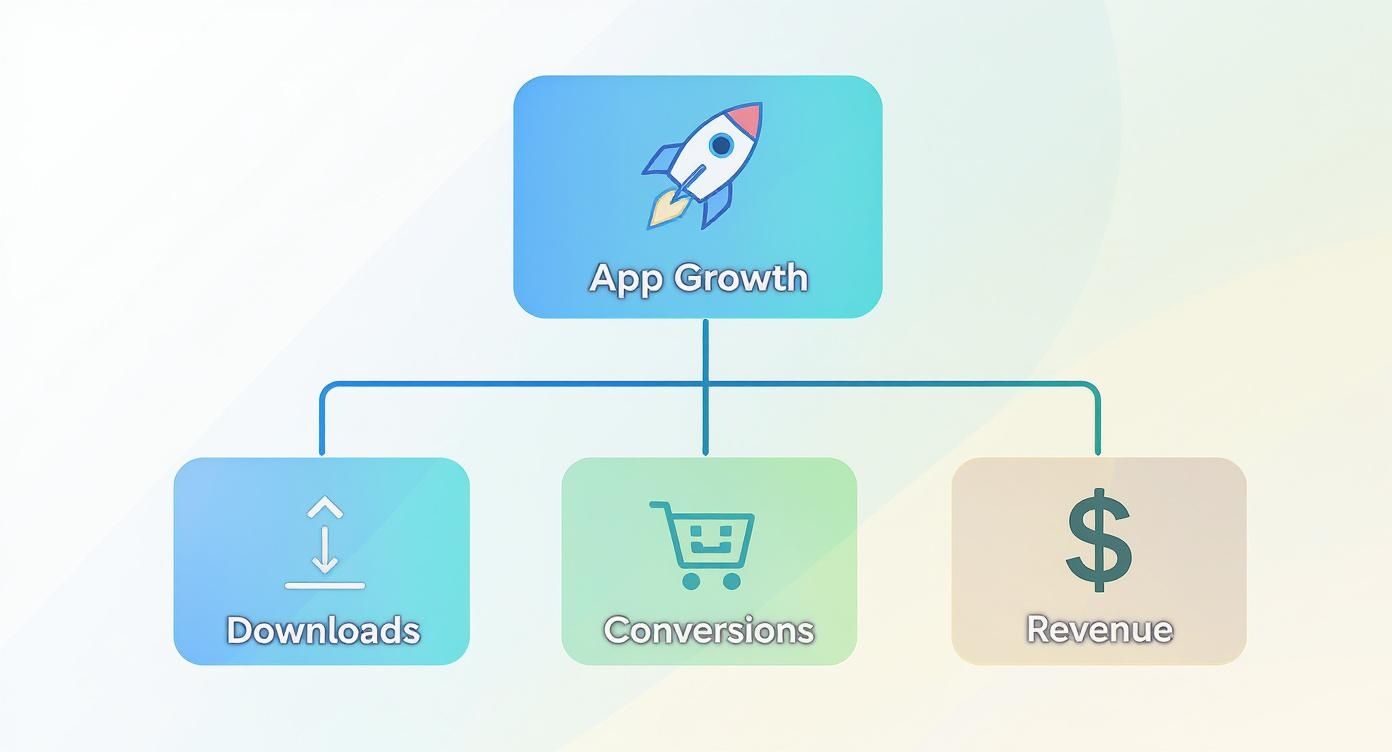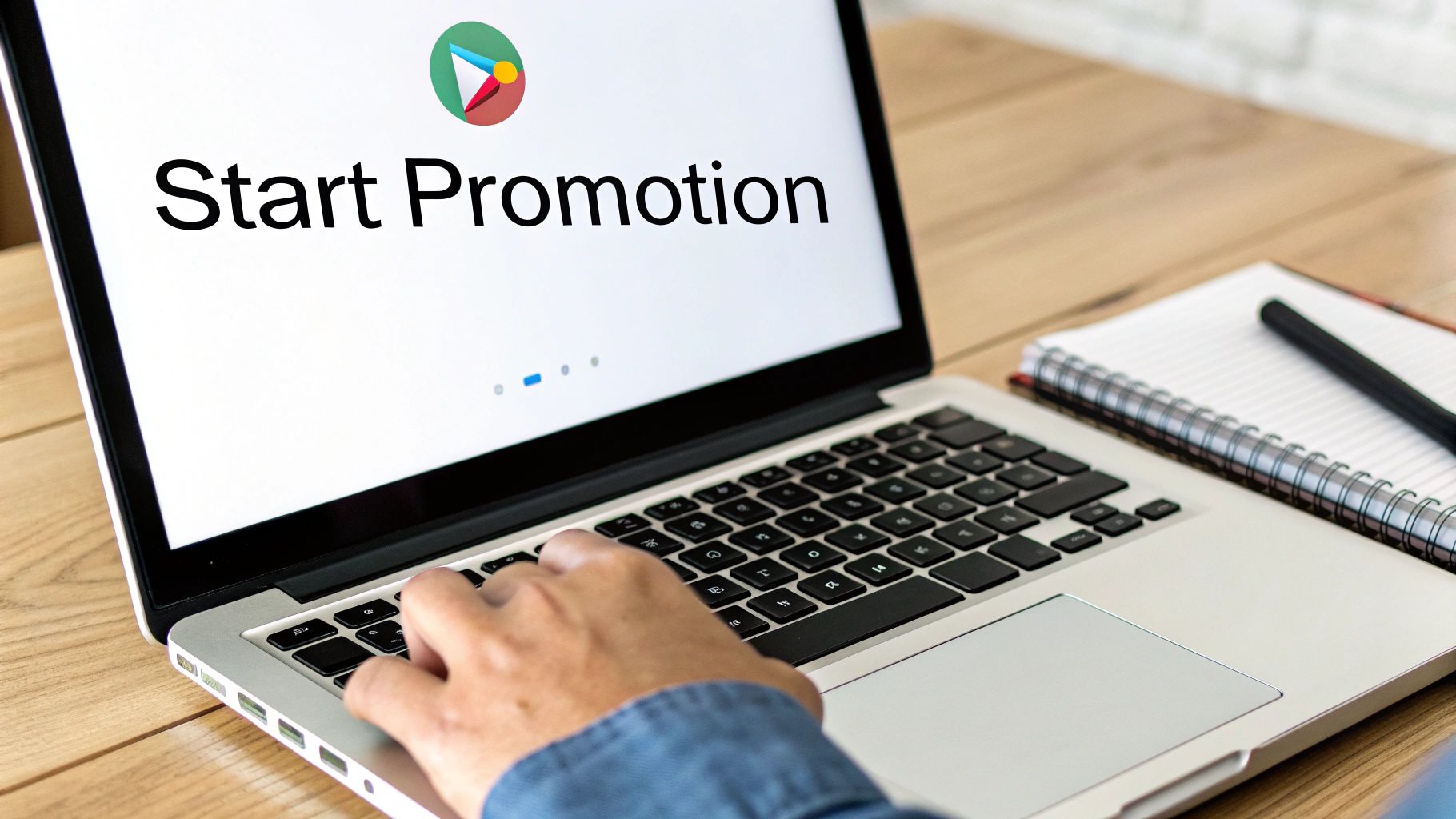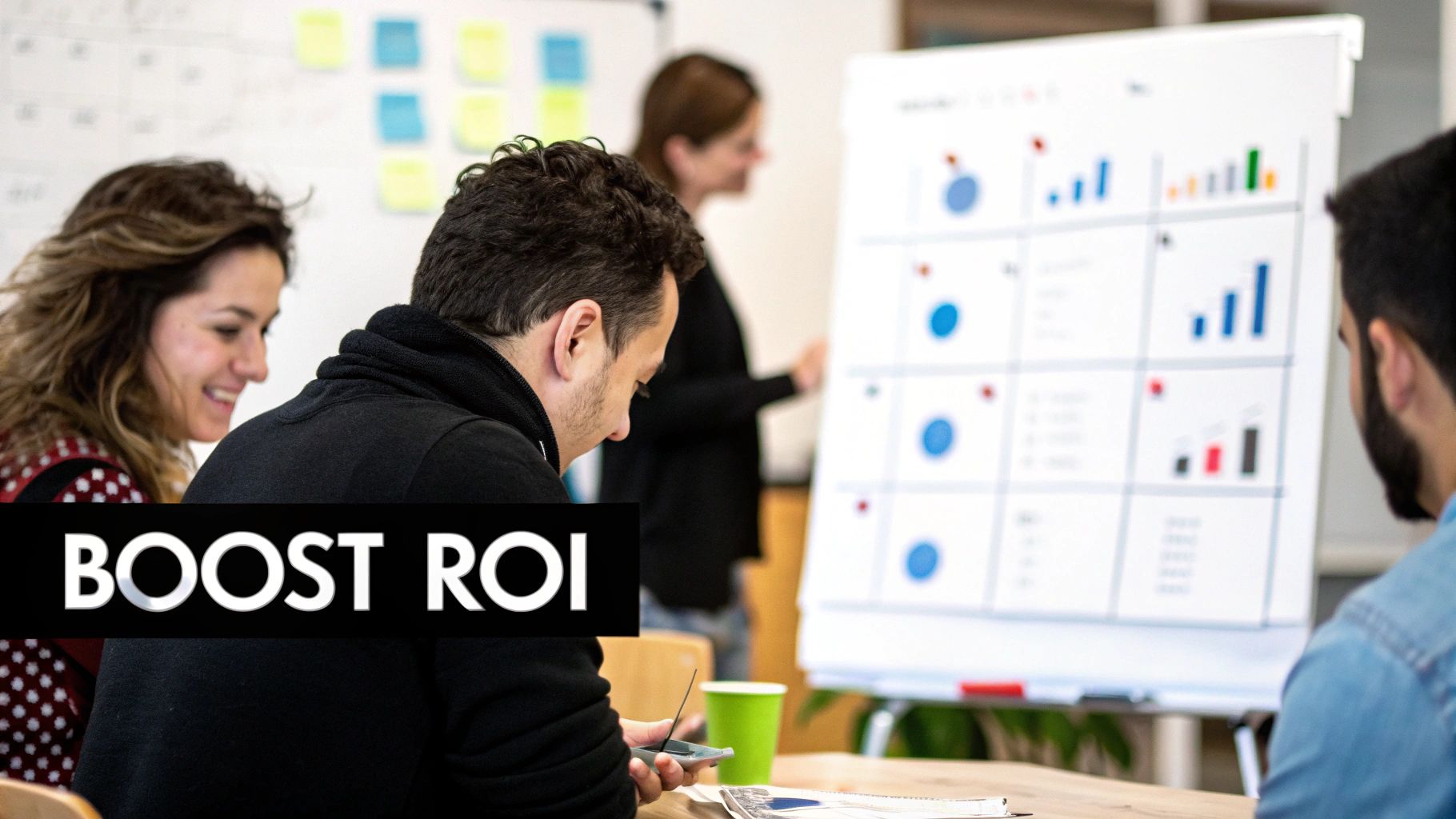
Your Guide to Google Play Discounts
Master Google Play discounts with this complete guide. Learn to create promotions that boost app downloads, user engagement, and revenue.
Feeling like you're shouting into the void in a packed app market? Strategic Google Play discounts can be your megaphone. They're a fantastic way to generate a sense of urgency, which can seriously boost downloads and nudge casual browsers into becoming paying customers. It’s the digital equivalent of a flash sale at your favorite store—it grabs attention and makes people act now.
Why Google Play Discounts Are a Growth Engine
Let's be real: in the app world, a great product alone often isn't enough to get noticed. You need to create specific moments that give users a reason to pull the trigger. A well-timed discount does exactly that.
When you temporarily drop the price of your app, a subscription, or an in-app purchase, you tap into a powerful psychological trigger. This feeling of scarcity and opportunity can be just the push someone on the fence needs to finally commit.
But this isn't just about a quick spike in sales. It's a key part of building a healthy user acquisition funnel. A successful promotion can set off a chain reaction—a surge of new users leads to more positive reviews, more social shares, and better visibility in the Play Store algorithm. That initial momentum can fuel organic growth long after your sale is over. To learn more about this, check out our guide on app user acquisition strategies and see how discounts fit into the bigger picture.
The Real-World Business Impact
The results of these promotions aren't just theoretical; they are tangible and often significant. We've seen discount-driven campaigns lift app downloads by up to 30% during the promotional window.
Even better, in-app purchase conversion rates can jump by as much as 40% when users are presented with a limited-time offer. This works especially well for gaming and productivity apps. You can find more data on this trend in these mobile app download statistics on tekrevol.com.
These numbers tell a clear story:
Strategic discounts aren't about devaluing your app. They're a calculated investment in its future growth, helping you acquire new users more cheaply and build a more engaged community.
By getting comfortable with Google Play's promotional tools, you can turn your app into a much more dynamic and profitable venture.
Choosing the Right Type of Promotion
Picking the right Google Play discounts is a lot like being a good mechanic—you need to know exactly which tool to grab for the job at hand. You wouldn't use a sledgehammer to fix a watch, right? The same logic applies here. The promotion you run has to line up perfectly with what you’re trying to achieve, whether that's bringing in a wave of new subscribers, winning back old users, or just giving your revenue a quick jolt.
Not all discounts are created equal. An introductory price might be the perfect hook for getting hesitant new users to commit, while a special promo code could be the ideal way to thank your most dedicated fans. Getting a handle on what each type of promotion does best is the first real step to launching a campaign that actually works.
Think of your app's growth like an engine. Downloads, conversions, and revenue are all interconnected parts that need to work together smoothly.

A well-planned discount doesn't just impact one of these areas; it creates a positive ripple effect across the board, giving your app some serious momentum.
Matching Promotions to Your Goals
Before you jump into the Google Play Console, you need to define what a "win" looks like for this campaign. Are you hunting for a huge number of new downloads? Or is your main goal to increase the average revenue you get from each user? Your answer will point you directly to the right promotional tool.
For instance, a free trial is a killer strategy for user acquisition. It completely removes the upfront financial risk, letting people experience the full value of your app before they have to pull out their wallets. This works especially well for subscription apps where you need to prove your long-term value.
Promo codes, on the other hand, offer a ton of flexibility. You can create unique codes for very specific groups of people—think influencer campaigns, customer support "make-goods," or rewards for your power users. This kind of targeted approach makes people feel special and is fantastic for building loyalty.
Here's a simple way to think about it: A free trial is like an open house, inviting everyone to come in and explore. A promo code is like a VIP ticket, giving a specific person an exclusive perk.
A Closer Look at Common Discount Types
Let's dive into the main promotional tools you have at your disposal in the Google Play Console and figure out where each one really shines.
To make it even clearer, this table breaks down the primary promotional tools, showing you where they fit best.
Comparison of Google Play Discount Types
| Discount Type | Best Use Case | Target Audience | Key Benefit |
|---|---|---|---|
| Introductory Pricing | Converting new users into long-term subscribers at the point of sign-up. | New or lapsed subscribers who have not previously purchased. | Reduces initial friction and makes the first payment less intimidating, boosting subscription conversion rates. |
| Promo Codes | Rewarding loyal users, running influencer campaigns, or resolving customer support issues. | Specific user segments, influencers' followers, or individual users. | Offers precise control and targeting, making it ideal for personalized offers and building community goodwill. |
| App-Wide Sales | Driving a significant, short-term spike in downloads or in-app purchase revenue. | All potential users browsing the Google Play Store. | Creates widespread urgency and high visibility, excellent for seasonal events or major app updates. |
By really thinking through your goals and who you're trying to reach, you can nail this choice. This alignment ensures your Google Play discounts aren’t just a giveaway, but a strategic move that helps build a more valuable and engaged user base for your app.
How to Set Up Your First Promotion
Now that you have a handle on the different Google Play discounts, you’re ready to get your hands dirty and launch your first campaign. The process itself is pretty straightforward, but the details really matter. Think of it like setting up a smart thermostat—get the parameters right once, and it runs your plan perfectly. But one wrong setting can leave you in the cold (or with a much lighter wallet).
Let’s walk through the steps inside the Google Play Console to make sure your promotion goes off without a hitch.
First things first, you'll want to head over to the monetization section in your app's dashboard. This is your command center for everything that makes you money, from managing your subscription plans to spinning up special offers. It's built to be the central hub where you can see exactly how your pricing experiments are panning out.
Here’s a look at the main dashboard of the Google Play Console, which is where we'll start.

From here, you have access to all the tools you'll need, including the specific sections for creating and keeping an eye on your promotions.
Defining Your Offer Details
Once you've decided on the type of promotion—let’s say, a promo code or an introductory price—it’s time to define the nitty-gritty terms. This is where your strategy becomes real, turning your plan into concrete rules that Google's system will follow to the letter.
Your first move is to name your offer. This is purely for your own sanity and internal tracking, so make it something you’ll recognize later, like "Q4 Holiday Sale 2024." Next up are the start and end dates. Pay close attention here. A classic mistake is getting the timeline wrong, causing a sale to go live too early or hang around too long. Always, always double-check the time zones to avoid any nasty surprises.
Then, you’ll set the actual discount. This can take a few different forms:
- A percentage off: Maybe 50% off the first three months of a subscription.
- A fixed amount: Something like a flat $5 discount on a one-time purchase.
- A free trial period: Offering 30 days free before the first payment hits.
What's your goal? A huge discount might pull in a flood of new sign-ups, but a smaller, longer-lasting discount could attract users who are more likely to stick around and have a higher lifetime value.
Setting Eligibility and Redemption Limits
Here’s where things get interesting. You don’t want to show every offer to every user. Smart targeting is what turns a generic discount into a powerful business tool. Thankfully, the Google Play Console gives you granular control over who qualifies for your promotion.
You can set eligibility based on a user's history with your app. For instance, you could create an offer exclusively for new subscribers. Or, you could craft a "win-back" campaign aimed squarely at users who have canceled in the past. This kind of segmentation is key to getting the right incentive in front of the right person at just the right moment.
A common pitfall is forgetting to set redemption limits for promo codes. If you don't, a code that gets shared on a public forum could be used thousands of times, costing you a fortune. Always set a maximum number of redemptions to protect your revenue.
Finally, before you hit that "Activate" button, review everything. One last time. Check the dates, the discount, the target audience, and any usage caps. A few extra minutes of proofreading can save you from costly headaches and make sure your first Google Play discounts campaign is a success that works exactly as you intended.
Strategies to Maximize Your Campaign ROI
Just launching a promotion isn't enough. If you really want to get the most out of your Google Play discounts, you have to think like a strategist. It's about moving beyond simple price cuts and building campaigns that actually deliver a measurable return. The real secret is being intentional with every single part of your offer, from how you time it to who you're targeting.
Timing is everything. A discount launched at just the right moment is like catching a perfect wave—it amplifies your effort and carries you so much further. Try aligning your promotions with major holidays, big seasonal events like Black Friday, or even your own significant app updates. This creates a natural buzz and makes your offer feel relevant.

When your offer feels connected to what's already on your users' minds, it stops feeling like a random sale and starts feeling like a timely, can't-miss opportunity.
Target Your Audience with Precision
One of the most powerful things you can do is audience segmentation. A one-size-fits-all discount rarely connects, because what motivates a new user is completely different from what a loyal customer or a lapsed subscriber wants. Tailoring your offers to these specific groups makes them exponentially more effective.
For instance, you could roll out a special "welcome" discount just for first-time installers to ease them into a subscription. On the flip side, you could design a "win-back" campaign aimed squarely at users who previously canceled, giving them an exclusive deal to come back.
This targeted approach isn't just smart marketing; it shows your users that you actually understand their relationship with your app and value them as individuals.
Think of segmentation as crafting a specific key for a specific lock. While a generic key might jiggle the lock open sometimes, a custom-cut key opens the door effortlessly every time. Your goal is to create that perfect offer for each user segment.
Test and Refine Your Offers
Never assume you know what will motivate your audience. A/B testing is your best friend for figuring out what truly drives conversions. You should be testing everything: different discount percentages, how long the promotion runs, and even the words you use to describe the offer.
Will a 25% discount for six months outperform a 50% discount for three months? There's only one way to know for sure: test it. The data you get from these experiments is gold, giving you the insights you need to make your future Google Play discounts hit the mark every time.
Digital coupons and promo codes have become a huge part of this. In price-sensitive markets like India, Brazil, and Indonesia, promotions driven by coupons can increase app downloads by up to 30% and lift in-app purchase rates by an incredible 40%. You can find more data on the effectiveness of coupon strategies on grabon.com. Those numbers prove that a well-aimed offer is one of the best tools you have for driving revenue.
And don't forget about the power of a great push notification. Announce your promotions with compelling messages that create a sense of urgency. A simple phrase like "Last Chance" or "Offer Ends Today" can be just the nudge someone needs to take action, making sure your carefully planned campaign gets the attention it deserves.
How to Measure Your Promotion's Success
So, you’ve launched your promotion. That’s the easy part. Now comes the real question: did your Google Play discounts actually move the needle?
To figure that out, we need to look past the vanity metrics. A temporary spike in downloads feels great, but it doesn't tell you much about the real, long-term impact on your app's financial health. It's like a sugar rush – you get a quick burst of energy, but it’s not the same as lasting nourishment.
A flood of new users is exciting, but if they churn immediately or never spend another dime, the promotion didn't build a sustainable business. The goal is to separate a fleeting blip in activity from a genuine increase in engaged, paying customers. That means digging into the data inside the Google Play Console and tracking the right stuff.
Key Metrics to Track
To get a clear picture of your campaign's performance, you need to focus on a few core metrics. These KPIs cut through the noise and show you what users are really doing during and after the promotion.
Redemption Rate: This one's straightforward. It's the percentage of people who saw your offer and actually took you up on it. If this number is low, it’s a sign that your discount wasn't compelling enough or you might have targeted the wrong audience.
Conversion Uplift: This is where the magic happens. How many more users converted to paying subscribers compared to a normal, non-promotional period? This metric ties your discount directly to new revenue.
User Lifetime Value (LTV): This is the ultimate test of your promotion's quality. Did the users you brought in through the discount stick around? Do they have a higher or lower LTV than your organic users? Ideally, you're not just finding bargain hunters; you're finding people who become valuable, long-term customers.
A successful promotion doesn't just attract one-and-done deal seekers. It brings in users who get a taste of your app's value and decide it's worth paying for again and again. Measuring LTV is how you know you've found them.
Analyzing the Long-Term Impact
Keeping an eye on these metrics helps you build a much smarter promotional strategy over time.
For instance, if you see a sky-high redemption rate but a dismal LTV, your discount might be too steep. You're attracting folks who only care about the deal and will likely never pay full price. This kind of insight is the bedrock of effective revenue optimization, helping you strike that perfect balance between user acquisition and profitability.
Don’t underestimate the power of a good discount. With global spending on Google Play projected to hit $65 billion by 2025, promotions are a massive lever. In fact, research shows that nearly 78% of all premium app purchases on the platform are influenced by some kind of promotional pricing. You can read more about these Google Play spending trends on owebest.com.
When you measure your campaigns correctly and make decisions based on data, you can ensure your promotions are driving real, sustainable growth—not just temporary noise.
So, What About iOS Promotions?
Don't let your hard-won promotional insights live and die in the Google Play Store. The lessons you've picked up from your Android campaigns are pure gold for your iOS strategy. Think about it: core ideas like segmenting your audience, testing different offers, and personalizing paywalls aren't platform-specific—they're just good business.
Consider your Google Play data a cheat sheet for iOS. If a 25% discount got a great response from your Android users, you've just found the perfect starting point for your first A/B test on the App Store. This isn't about copying and pasting; it's about skipping the painful guesswork and jumping straight to refining an offer that already has a proven track record.
Creating a Unified Cross-Platform Strategy
The real win is building a monetization strategy that feels cohesive, whether a user is on a Pixel or an iPhone. What you learn on one platform can directly supercharge your growth on the other. For example, did you discover that Android users jump on a weekend flash sale? That's a huge clue for scheduling your next iOS promotion.
Your Android promotion data isn't just for Android; it's a treasure trove of behavioral insights you can immediately apply to your iOS paywalls, building a smarter, more profitable strategy for your entire user base.
This mindset forces you to get the most out of every single piece of data you collect. Whether you’re tweaking your pricing tiers or fine-tuning introductory offers, those cross-platform insights are invaluable. If you want to dive deeper into how these offers work on a technical level, check out our guide on implementing free trials and other product promotions.
Common Questions About Google Play Discounts
Once you start digging into Google Play discounts, you’ll probably find yourself with a handful of questions. It's totally normal. As you get ready to launch your first campaigns, a few common uncertainties tend to pop up, covering everything from how the money works to the technical nitty-gritty. Let’s tackle some of the most frequent ones.
First up, the big one: revenue share. Does Google still take its cut from a discounted price? Yep, they do. The standard transaction fee applies to the final price the customer pays. Think of it this way—the discount comes off the top, and then Google calculates its fee on that smaller, final amount.
Another question I hear all the time is about stacking promotions. Can a user combine multiple offers? Generally, no. The Google Play Console is smart enough to prevent this. If a user happens to be eligible for more than one of your deals, the system automatically gives them the single best discount available.
Strategic and Technical Concerns
Okay, let's get into strategy. How often should you actually run promotions? There’s no magic formula, but a solid rule of thumb is to tie them to moments that matter: big holidays, a major app update, or seasonal shifts. Be careful not to overdo it, though. Constant sales can make your app feel cheap and train users to just wait for the next price drop.
A classic mistake is to "set it and forget it." You have to watch your campaign's performance as it happens. If a discount isn't bringing in the numbers you hoped for, it's far better to pull the plug early and figure out what went wrong than to let it limp to the finish line.
Finally, can you target discounts to specific countries? Absolutely, and you definitely should. This is one of the most powerful tools in your arsenal. You can create promotions with pricing and messaging that make sense for the local economy and culture, which makes your Google Play discounts way more effective when you're operating globally.
Ready to translate your promotional insights into flawless iOS paywalls? With Nuxie, you can design, target, and ship high-converting offers in minutes without an app update. Explore how our AI-powered studio and campaign builder can help you grow subscription revenue at https://nuxie.io.